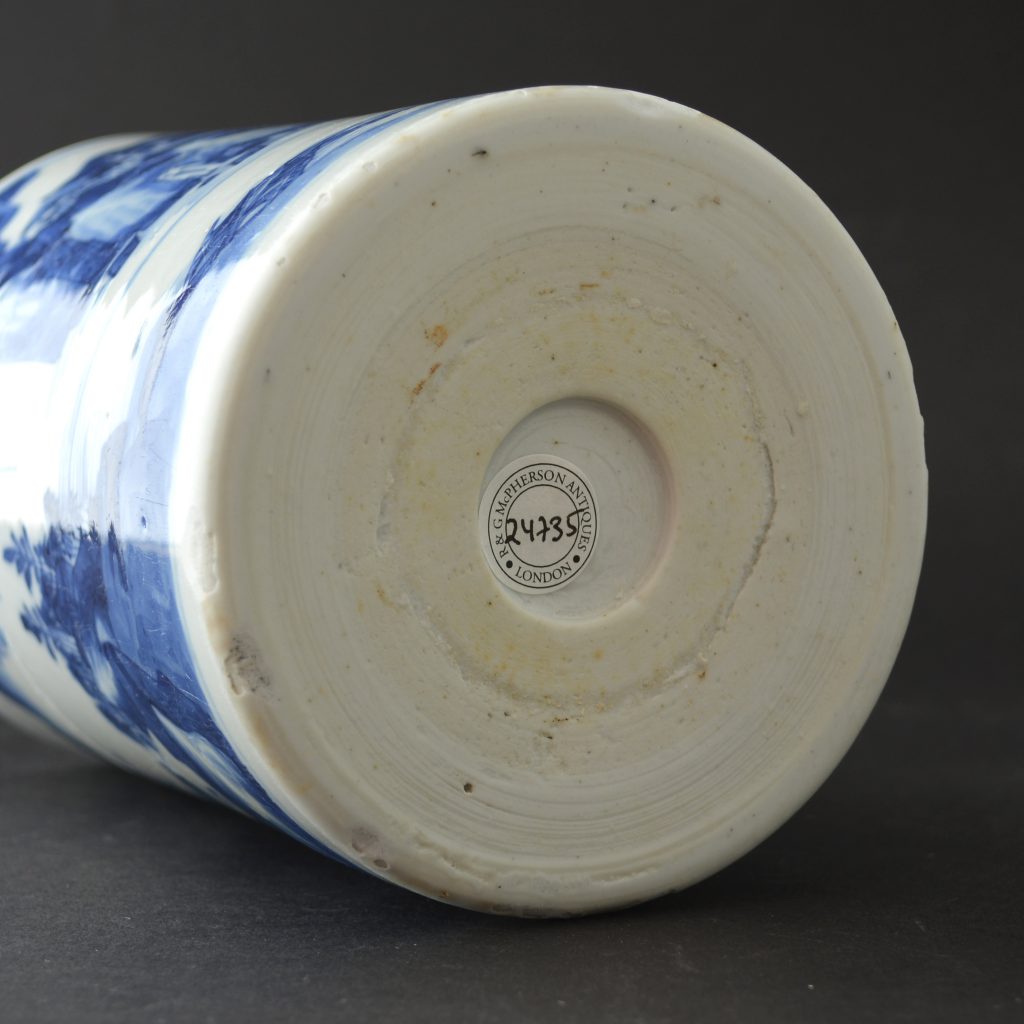
A Kangxi Blue and White Porcelain ‘Bitong’ or Brushpot c.1700.
A well painted Kangxi Blue and White porcelain Bitong (brushpot) c.1700. Decorated with an extensive continuous landscape of two scholars among jagged mountains with water in the foreground.
- Condition
- In excellent condition, the lower edge with quite a lot of fritting / glaze chips and minor chips.
- Size
- Height : 15 cm (6 inches)
- Provenance
- From the collection of the late Peter Winkworth (1929-2005) 2 Campden Hill Place, London. Born in 1929, the son of a Canadian mother and an English father, Peter Winkworth was educated in Montreal and read History at Wadham College, Oxford before embarking on a career in the City of London with a firm of Canadian stockbrokers. His career was curtailed when he lost a leg in a boating accident off Monte Carlo, and he began collecting Canadiana in earnest during his year of convalescence. While still in his wheelchair, he married Franca Lombardi, the daughter of the Italian First World War fighter ace and pioneer aviator “Francis” Lombardi, in New York. He quickly mastered his artificial leg and embarked on a six-week tour of Europe with New York print dealer Harry Shaw Newman who introduced him to key contacts and destinations in the print and antiquarian collecting world. In the ensuing years, Peter, who struck a remarkable figure with his gold tipped cane, would become a familiar character to the printselling trade and a fixture on the auction circuit in London and Montreal. It was he, rather than the auction Christie’s held at the Ritz Carlton in Montreal in 1969, who stole the show for the local saleroom columnist Brian McKenna: ‘Peter Winkworth was there … Surely you know Peter. Has a house like an art museum in London. Youngish, about 35. Spends his life jetting around the world from art auction to art auction. Scads of money. Terribly hard to please. “If Peter comes to your auction,” confided a nice lady from Christie’s, the auction people, “then it’s made.”’ Winkworth’s own collecting of Canadiana had been kindled in the 1940s when his uncle John Bernard sold him a set of Cockburn’s Canadian views. His English grandfather Henry and English uncle Bill had both collected Chinese porcelain on a grand scale, with the dispersal of Stephen’s collections in week-long auctions in London in the 1920s and ’30s, so serious collecting was in the blood, and true to his forebears Peter Winkworth began to put together what would become arguably the most extensive private collection of Canadiana ever assembled. The collection adorned the walls of the Winkworth’s elegant London home, the Colefax & Fowler decorated house at 2 Campden Hill Place in Kensington.
- Stock number
- 24735
Information
Brushpots / Bitong :
Bitong, brushpots are not found in 17th or early 18th century European inventories unlike some other ceramic forms which fore fill a specific Chinese function. Blanc de chine `libation cups`, were for example, made for drinking wine in China but they were imported in large numbers to the West. There curious forms appealed to Western tastes and were used in European displays or converted with the addition of a gilt bronze handle to become a bonbon dishes. Brushpots on the other hand seem to have been made exclusively for the Chinese domestic market and perhaps also for Chinese scholars in South East Asia. Bitong are an essential part of literati`s desk equipment, what is often referred to as a scholars desk. Other scholarly items for the desk might include a brush-rest, inkstone (for grinding the dry ink) a water pot for the water to add to the inkstone, a brushwasher as well as a table screen. Like other scholar`s objects they were made in a diverse range of material from natural gnarled branches of trees, highly polished wood, jade, bamboo to name but a few. Brush-rests were used for keeping the brush from making stains on the scholar`s table in between use while the scholar was working, while brush pots were used for storing the brushes when they were not being used.








